Gravel Mulching Significantly Improves Crop Yield and Water Productivity in Arid and Semi-Arid Regions of Northwest China: Evidence from a Meta-Analysis
Agricultural Water Management in Arid, Semi-Arid and Drought Prone Areas—2nd Edition
)
Abstract
:1. Introduction
2. Materials and Methods
2.1. Data Collection
2.2. Data Classification
2.3. Meta-Analysis
2.4. Statistical Analyses
3. Results
3.1. Effects of GM on Crop Yield and WP
3.1.1. Overall Effects
3.1.2. Regional Factors
3.1.3. Time Factors
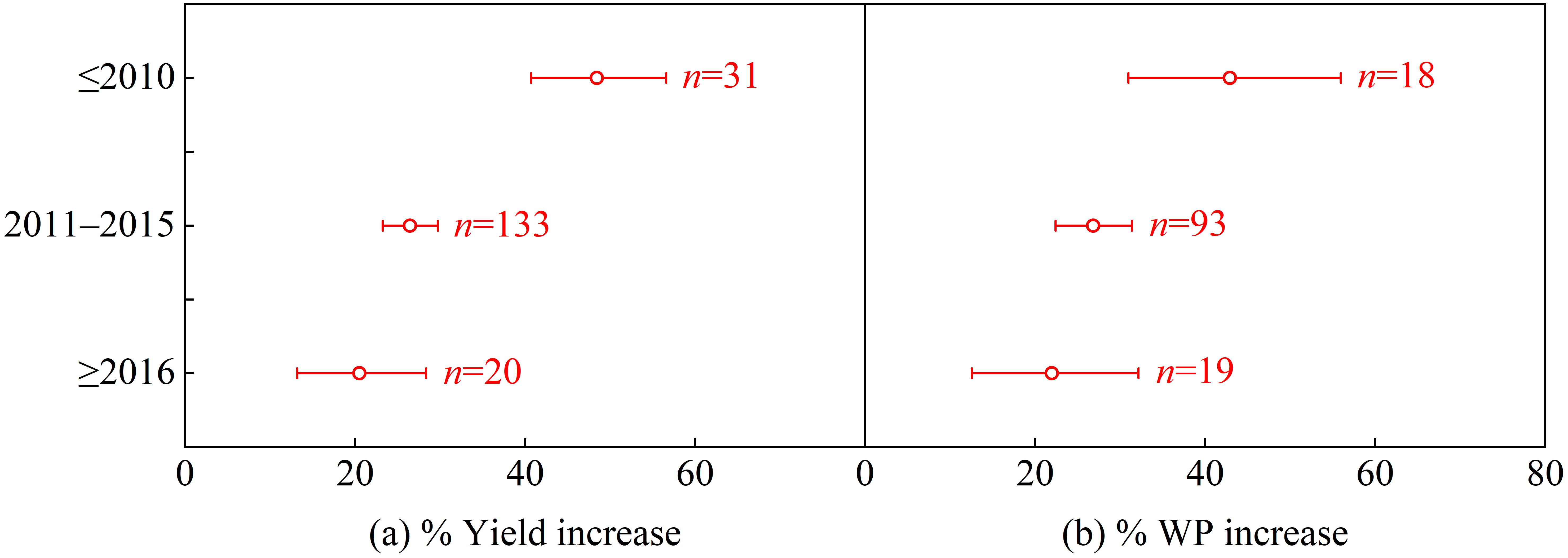
3.1.4. Gravel Characterization Factors
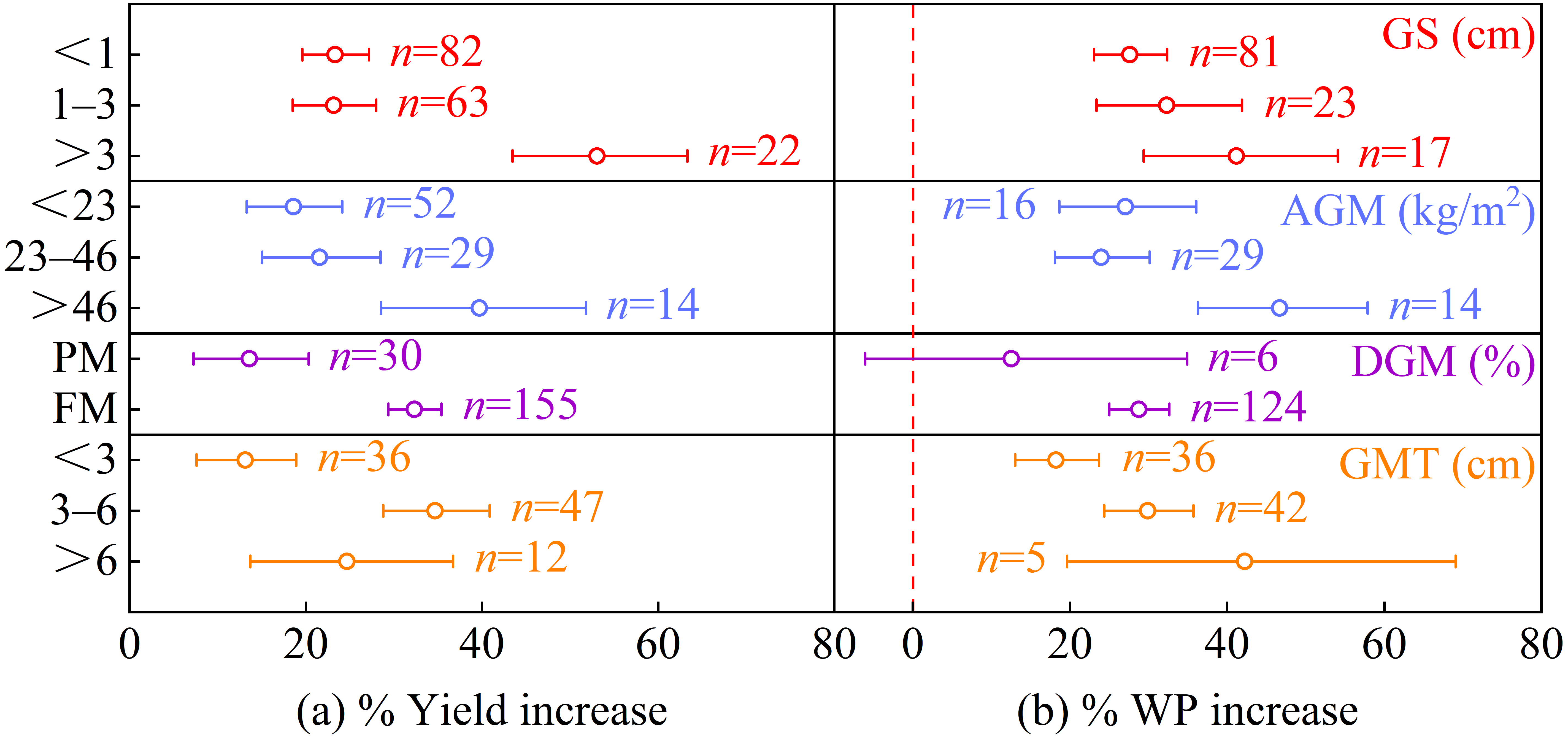
3.1.5. Management Factors
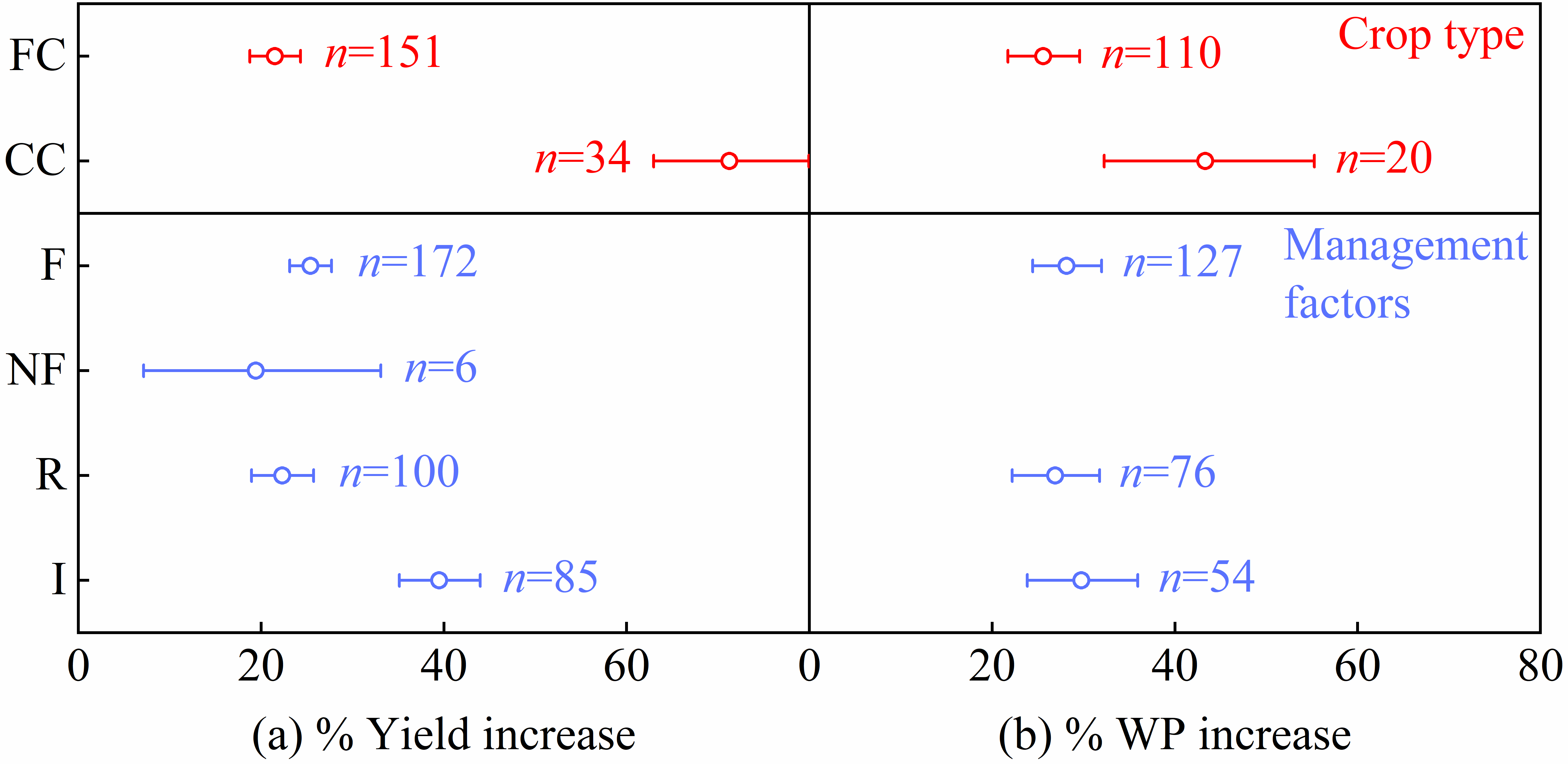
3.2. Regression Analysis of Effects of GM on Crop Yield and WP
3.2.1. Single-Factor Regression Analysis
3.2.2. Stepwise Multiple Linear Regression Analysis and Path Analysis
4. Discussion
4.1. Effects of GM on Crop Yield and WP
4.2. Impact Factors for Crop Yield and WP
4.2.1. Effects of Regional Factors on Crop Yield and WP
4.2.2. Effects of Time Factors on Crop Yield and WP
4.2.3. Effects of Gravel Characterization Factors on Crop Yield and WP
4.2.4. Effects of Management Factors on Crop Yield and WP
5. Conclusions
Author Contributions
Funding
Data Availability Statement
Conflicts of Interest
References
- Ruiz-Lozano, J.M.; Aroca, R.; Zamarreño, Á.M.; Molina, S.; Andreo-Jiménez, B.; Porcel, R.; García-Mina, J.M.; Ruyter-Spira, C.; López-Ráez, J.A. Arbuscular mycorrhizal symbiosis induces strigolactone biosynthesis under drought and improves drought tolerance in lettuce and tomato. Plant Cell Environ. 2016, 39, 441–452. [Google Scholar] [CrossRef] [PubMed]
- Schimel, D.S. Drylands in the earth system. Science 2010, 327, 418–419. [Google Scholar] [CrossRef] [PubMed]
- Rosa, L.; Chiarelli, D.D.; Rulli, M.C.; Dell’Angelo, J.; D’Odorico, P. Global agricultural economic water scarcity. Sci. Adv. 2020, 6, eaaz6031. [Google Scholar] [CrossRef] [PubMed]
- Li, C.J.; Wang, C.J.; Wen, X.X.; Qin, X.L.; Liu, Y.; Han, J.; Li, Y.J.; Liao, Y.C.; Wu, W. Ridge-furrow with plastic film mulching practice improves maize productivity and resource use efficiency under the wheat-maize double-cropping system in dry semi-humid areas. Field Crop. Res. 2017, 203, 201–211. [Google Scholar] [CrossRef]
- Sun, Z.; Zheng, Y.; Li, X.; Tian, Y.; Han, F.; Zhong, Y.; Liu, J.; Zheng, C.M. The Nexus of water, ecosystems, and agriculture in Endorheic River Basins: A system analysis based on integrated ecohydrological modeling. Water Resour. Res. 2018, 54, 7534–7556. [Google Scholar] [CrossRef]
- Fernández, J.E.; Alcon, F.; Diaz-Espejo, A.; Hernandez-Santana, V.; Cuevas, M.V. Water use indicators and economic analysis for on-farm irrigation decision: A case study of a super high density olive tree orchard. Agric. Water Manag. 2020, 237, 106074. [Google Scholar] [CrossRef]
- Raeisi, L.G.; Morid, S.; Delavar, M.; Srinivasan, R. Effect and side-effect assessment of different agricultural water saving measures in an integrated framework. Agric. Water Manag. 2019, 223, 105685. [Google Scholar] [CrossRef]
- Rodrigues, G.C.; Pereira, L.S. Assessing economic impacts of deficit irrigation as related to water productivity and water costs. Biosyst. Eng. 2009, 103, 536–551. [Google Scholar] [CrossRef]
- Gan, Y.T.; Siddique, K.H.M.; Turner, N.C.; Li, X.G.; Niu, J.Y.; Yang, C.; Liu, L.P.; Chai, Q. Ridge-Furrow Mulching Systems—An Innovative Technique for Boosting Crop Productivity in Semiarid Rain-Fed Environments. Adv. Agron. 2013, 118, 429–476. [Google Scholar] [CrossRef]
- Idoje, G.; Dagiuklas, T.; Iqbal, M. Survey for smart farming technologies: Challenges and issues. Comput. Electr. Eng. 2021, 92, 107104. [Google Scholar] [CrossRef]
- Qin, S.H.; Zhang, J.L.; Dai, H.L.; Wang, D.; Li, D.M. Effect of ridge-furrow and plastic-mulching planting patterns on yield formation and water movement of potato in a semi-arid area. Agric. Water Manag. 2014, 131, 87–94. [Google Scholar] [CrossRef]
- El-Beltagi, H.S.; Basit, A.; Mohamed, H.I.; Ali, I.; Ullah, S.; Kamel, E.A.; Shalaby, T.A.; Ramadan, K.M.A.; Alkhateeb, A.A.; Ghazzawy, H.S. Mulching as a sustainable water and soil saving practice in agriculture: A review. Agronomy 2022, 12, 1881. [Google Scholar] [CrossRef]
- Kader, M.A.; Senge, M.; Mojid, M.A.; Ito, K. Recent advances in mulching materials and methods for modifying soil environment. Soil Tillage Res. 2017, 168, 155–166. [Google Scholar] [CrossRef]
- Abduwaiti, A.; Liu, X.W.; Yan, C.R.; Xue, Y.H.; Jin, T.; Wu, H.Q.; He, P.C.; Bao, Z.; Liu, Q. Testing biodegradable films as alternatives to plastic-film mulching for enhancing the yield and economic benefits of processed tomato in Xinjiang region. Sustainability 2021, 13, 3093. [Google Scholar] [CrossRef]
- Nawaz, A.; Lal, L.; Shrestha, R.K.; Farooq, M. Mulching Affects Soil Properties and Greenhouse Gas Emissions Under Long-term No-Till and Plough-Till Systems in Alfisol of Central Ohio. Land Degrad. Dev. 2017, 28, 673–681. [Google Scholar] [CrossRef]
- Li, S.Y.; Li, Y.; Lin, H.X.; Feng, H.; Dyck, M. Effects of different mulching technologies on evapotranspiration and summer maize growth. Agric. Water Manag. 2018, 201, 309–318. [Google Scholar] [CrossRef]
- Suo, G.D.; Xie, Y.S.; Zhang, Y.; Luo, H. Long-term effects of different surface mulching techniques on soil water and fruit yield in an apple orchard on the Loess Plateau of China. Sci. Hortic. 2019, 246, 643–651. [Google Scholar] [CrossRef]
- Liu, E.K.; He, W.Q.; Yan, C.R. ‘White revolution’ to ‘white pollution’—Agricultural plastic film mulch in China. Environ. Res. Lett. 2014, 9, 091001. [Google Scholar] [CrossRef]
- Lundgren, J.G.; Fergen, J.K. The effects of a winter cover crop on diabrotica virgifera (coleoptera: Chrysomelidae) populations and beneficial arthropod communities in no-till maize. Environ. Entomol. 2010, 39, 1816–1828. [Google Scholar] [CrossRef]
- Jia, Z.J.; Liu, X.Z.; Li, W.C.; Liu, Q.L.; Chen, J.H.; Yao, X.C.; Xu, T.Y. Evolution and regulation of soil quality and land productivity in continuous cropping gravel-sand mulched field in arid region: Progress and perspective. Acta Ecol. Sin. 2024, 44, 2136–2148, (In Chinese with English Abstract). [Google Scholar] [CrossRef]
- Li, X.Y.; Gong, J.D.; Gao, Q.Z.; Wei, X.H. Rainfall interception loss by pebble mulch in the semiarid region of China. J. Hydrol. 2000, 228, 165–173. [Google Scholar] [CrossRef]
- Wang, M.; Sun, Y.W. Fruit trees and vegetables for arid and semi-arid areas in north-west China. J. Arid Environ. 1986, 11, 3–16. [Google Scholar] [CrossRef]
- Li, X.Y. Gravel-sand mulch for soil and water conservation in the semiarid loess region of northwest China. CATENA 2003, 52, 105–127. [Google Scholar] [CrossRef]
- Poesen, J.; Lavee, H. Rock fragments in top soils: Significance and processes. CATENA 1994, 23, 1–28. [Google Scholar] [CrossRef]
- Kessler, N.V. Base cation evidence for enhanced water infiltration in Ancestral Pueblo gravel mulch fields, Northern New Mexico, USA. Geoarchaeology 2022, 37, 858–869. [Google Scholar] [CrossRef]
- Nachtergaele, J.; Poesen, J.; Wesemael, B.V. Gravel mulching in vineyards of southern Switzerland. Soil Tillage Res. 1998, 46, 51–59. [Google Scholar] [CrossRef]
- Dlamini, P.; Ukoh, I.B.; Van Rensburg, L.D.; Preez, C.C. Reduction of evaporation from bare soil using plastic and gravel mulches and assessment of gravel mulch for partitioning evapotranspiration under irrigated canola. Soil Res. 2016, 55, 222–233. [Google Scholar] [CrossRef]
- Xia, L.; Song, X.Y.; Fu, N.; Cui, S.Y.; Li, L.J.; Li, H.Y.; Li, Y.L. Effects of rock fragment cover on hydrological processes under rainfall simulation in a semi-arid region of China. Hydrol. Process. 2018, 32, 792–804. [Google Scholar] [CrossRef]
- Yuan, C.P.; Lei, T.W.; Mao, L.L.; Liu, H.; Wu, Y. Soil surface evaporation processes under mulches of different sized gravel. CATENA 2009, 78, 117–121. [Google Scholar] [CrossRef]
- Bonachela, S.; López, J.C.; Granados, M.R.; Magán, J.J.; Hernández, J.; Baille, A. Effects of gravel mulch on surface energy balance and soil thermal regime in an unheated plastic greenhouse. Biosyst. Eng. 2020, 192, 1–13. [Google Scholar] [CrossRef]
- Li, H.R.; Zou, X.Y.; Zhang, C.L.; Kang, L.Q.; Cheng, H.; Liu, B.; Liu, W.; Fang, Y.; Yang, D.L.; Wu, X.X. Effects of gravel cover on the near-surface airflow field and soil wind erosion. Soil Tillage Res. 2021, 214, 105133. [Google Scholar] [CrossRef]
- Qiu, Y.; Lv, W.; Wang, X.; Wang, Y.; Li, J.; Xie, Z. Runoff and soil and nutrient losses from gravel mulching: A field experiment with natural rainfall on the Loess Plateau of China. J. Soil Water Conserv. 2021, 76, 359–368. [Google Scholar] [CrossRef]
- Gu, X.; Yang, N.; Zhao, Y.; Liu, W.H.; Li, T.F. Long-term watermelon continuous cropping leads to drastic shifts in soil bacterial and fungal community composition across gravel mulch fields. BMC Microbiol. 2022, 22, 189. [Google Scholar] [CrossRef] [PubMed]
- Liu, Q.L.; Li, Y.Y.; Li, W.C.; Su, Q.K.; Ma, B.; Mu, M.; Jia, Z.J.; Zhao, G.X. Effect of the Release of Gravel Elements on Soil Nutrients and Jujube Fruit Yield under Wet-and-Dry Cycles. Agronomy 2022, 12, 2881. [Google Scholar] [CrossRef]
- Qiu, Y.; Wang, Y.J.; Xie, Z.K. Long-term gravel-sand mulch affects soil physicochemical properties, microbial biomass and enzyme activities in the semi-arid loess plateau of North-Western China. Acta Agric. Scand. Sect. B Soil Plant Sci. 2014, 64, 294–303. [Google Scholar] [CrossRef]
- Li, C.X.; Li, Y.J.; Fu, G.Z.; Huang, M.; Ma, C.; Wang, H.Z.; Zhang, J. Cultivation and mulching materials strategies to enhance soil water status, net ecosystem and crop water productivity of winter wheat in semi-humid regions. Agric. Water Manag. 2020, 239, 106240. [Google Scholar] [CrossRef]
- Wang, D.L.; Feng, H.; Liu, X.Q.; Li, Y.; Zhou, L.F.; Zhang, A.F.; Dyck, M. Effects of gravel mulching on yield and multilevel water use efficiency of wheat-maize cropping system in semi-arid region of Northwest China. Field Crop. Res. 2018, 218, 201–212. [Google Scholar] [CrossRef]
- Wang, X.X.; Cheng, Z.L.; Cheng, X.; Wang, Q.J. Effects of Surface Mulching on the Growth and Water Consumption of Maize. Agriculture 2022, 12, 1868. [Google Scholar] [CrossRef]
- Glass, G.V. Primary, secondary, and meta-analysis of research. Educ. Res. 1976, 5, 3–8. [Google Scholar] [CrossRef]
- Li, H.; Chang, W.Y. Exploring optimal film mulching to enhance potato yield in China: A meta-analysis. Agron. J. 2021, 113, 4099–4115. [Google Scholar] [CrossRef]
- Adu, M.O.; Yawson, D.O.; Armah, F.A.; Asare, P.A.; Frimpong, K.A. Meta-analysis of crop yields of full, deficit, and partial root-zone drying irrigation. Agric. Water Manag. 2018, 197, 79–90. [Google Scholar] [CrossRef]
- Yang, C.; Zhang, W.Y.; Gu, H.H.; Liu, A.H.; Guo, Q.; Chen, Y.Z.; Lu, J.W.; Ren, T.; Cong, R.H.; Lu, Z.F.; et al. Field, plant, to leaf: A meta-analysis on crop water use efficiency response to potassium fertilization. J. Hydrol. 2023, 621, 129578. [Google Scholar] [CrossRef]
- Gao, Y.; Shao, G.C.; Wu, S.Q.; Wang, X.J.; Lu, J.; Cui, J.T. Changes in soil salinity under treated wastewater irrigation: A meta-analysis. Agric. Water Manag. 2021, 255, 106986. [Google Scholar] [CrossRef]
- Zhou, Z.H.; Wang, C.K.; Zheng, M.H.; Jiang, L.F.; Luo, Y.K. Patterns and mechanisms of responses by soil microbial communities to nitrogen addition. Soil Biol. Biochem. 2017, 115, 433–441. [Google Scholar] [CrossRef]
- Hedges, L.V.; Gurevitch, J.; Curtis, P.S. The meta-analysis of response ratios in experimental ecology. Ecology 1999, 80, 1150–1156. [Google Scholar] [CrossRef]
- Curtis, P.S.; Wang, X.Z. A meta-analysis of elevated CO2 effects on woody plant mass, form, and physiology. Oecologia 1998, 113, 299–313. [Google Scholar] [CrossRef] [PubMed]
- Rosenthal, R. The file drawer problem and tolerance for null results. Psychol. Bull. 1979, 86, 638–641. [Google Scholar] [CrossRef]
- Yin, M.H.; Ma, Y.L.; Kang, Y.X.; Jia, Q.; Qi, G.P.; Wang, J.H.; Yang, C.K.; Yu, J.X. Optimized farmland mulching improves alfalfa yield and water use efficiency based on meta-analysis and regression analysis. Agric. Water Manag. 2022, 267, 107617. [Google Scholar] [CrossRef]
- Yue, J.B.; Zhou, C.Q.; Guo, W.; Feng, H.K.; Xu, K.J. Estimation of winter-wheat above-ground biomass using the wavelet analysis of unmanned aerial vehicle-based digital images and hyperspectral crop canopy images. Int. J. Remote Sens. 2020, 42, 1602–1622. [Google Scholar] [CrossRef]
- Eze, E.; Girma, A.; Zenebe, A.; Okolo, C.C.; Kourouma, J.M.; Negash, E. Predictors of drought-induced crop yield/losses in two agroecologies of southern Tigray, Northern Ethiopia. Sci. Rep. 2022, 12, 6284. [Google Scholar] [CrossRef]
- Federer, C.A. A soil-plant-atmosphere model for transpiration and availability of soil water. Water Resour. Res. 1979, 15, 555–562. [Google Scholar] [CrossRef]
- Wang, Y.J.; Xie, Z.K.; Li, F.M.; Zhang, Z.S. The effect of supplemental irrigation on watermelon (Citrullus lanatus) production in gravel and sand mulched fields in the Loess Plateau of Northwest China. Agric. Water Manag. 2004, 69, 29–41. [Google Scholar] [CrossRef]
- Yamanaka, T.; Inoue, M.; Kaihotsu, I. Effects of gravel mulch on water vapor transfer above and below the soil surface. Agric. Water Manag. 2004, 67, 145–155. [Google Scholar] [CrossRef]
- Gupta, A.; Rico-Medina, A.; Caño-Delgado, A.I. The physiology of plant responses to drought. Science 2020, 368, 266–269. [Google Scholar] [CrossRef] [PubMed]
- Bu, L.D.; Liu, J.L.; Zhu, L.; Luo, S.S.; Chen, X.P.; Li, S.Q.; Lee Hill, R.; Zhao, Y. The effects of mulching on maize growth, yield and water use in a semi-arid region. Agric. Water Manag. 2013, 123, 71–78. [Google Scholar] [CrossRef]
- Zhu, L.; Liu, J.L.; Luo, S.S.; Bu, L.D.; Chen, X.P.; Li, S.Q. Soil mulching can mitigate soil water deficiency impacts on rainfed maize production in semiarid environments. J. Integr. Agric. 2015, 14, 58–66. [Google Scholar] [CrossRef]
- Xie, Z.K.; Wang, Y.J.; Cheng, G.D.; Malhi, S.S.; Vera, C.L.; Guo, Z.H.; Zhang, Y.B. Particle-size effects on soil temperature, evaporation, water use efficiency and watermelon yield in fields mulched with gravel and sand in semi-arid Loess Plateau of northwest China. Agric. Water Manag. 2010, 97, 917–923. [Google Scholar] [CrossRef]
- Qi, G.P.; Kang, Y.X.; Yin, M.H.; Ma, Y.L.; Bai, Y.S.; Wang, J.H. Yield responses of wheat to crop residue returning in China: A meta-analysis. Crop Sci. 2019, 59, 2185–2200. [Google Scholar] [CrossRef]
- Mbava, N.; Mutema, M.; Zengeni, R.; Shimelis, H.; Chaplot, V. Factors affecting crop water use efficiency: A worldwide meta-analysis. Agric. Water Manag. 2020, 228, 105878. [Google Scholar] [CrossRef]
- Zhao, C.Z.; Wang, Y.J.; Qiu, Y.; Xie, Z.K.; Zhang, Y.B. Long-term effects of gravel-sand mulch thickness on soil microbes and enzyme activities in semi-arid Loess Plateau, Northwest China. Sci. Cold Arid Reg. 2021, 13, 510–521. [Google Scholar] [CrossRef]
- Wang, D.L.; Feng, H.; Li, Y.; Zhang, T.B.; Dyck, M.; Wu, F. Energy input-output, water use efficiency and economics of winter wheat under gravel mulching in Northwest China. Agric. Water Manag. 2019, 222, 354–366. [Google Scholar] [CrossRef]
- Liu, X.Q.; Feng, H.; Wang, D.L.; Yu, K.; Zuo, Y.Q. Effect of gravel mulching on soil moisture, growth and yield of winter wheat. J. Northwest AF Univ. (Nat. Sci. Ed.) 2017, 45, 96–104+114, (In Chinese with English Abstract). [Google Scholar] [CrossRef]
- Khorsandi, F. Soil water conservation by course textured volcanic rock mulch. Asian J. Exp. Biol. Sci. 2011, 2, 762–765. [Google Scholar]
- Bai, Y.R.; Zhao, Y.P.; Wang, Y.Q.; Zhang, X. Soil Infiltration Process and Model Analysis of Field Mulched with Different Thickness of Gravel-Sand in Ningxia. J. Soil Water Conserv. 2017, 31, 81–85, (In Chinese with English Abstract). [Google Scholar] [CrossRef]
- Yu, H.C.; Li, S.; Ding, J.; Yang, T.Y.; Wang, Y.X. Water use efficiency and its drivers of two typical cash crops in an arid area of Northwest China. Agric. Water Manag. 2023, 287, 108433. [Google Scholar] [CrossRef]
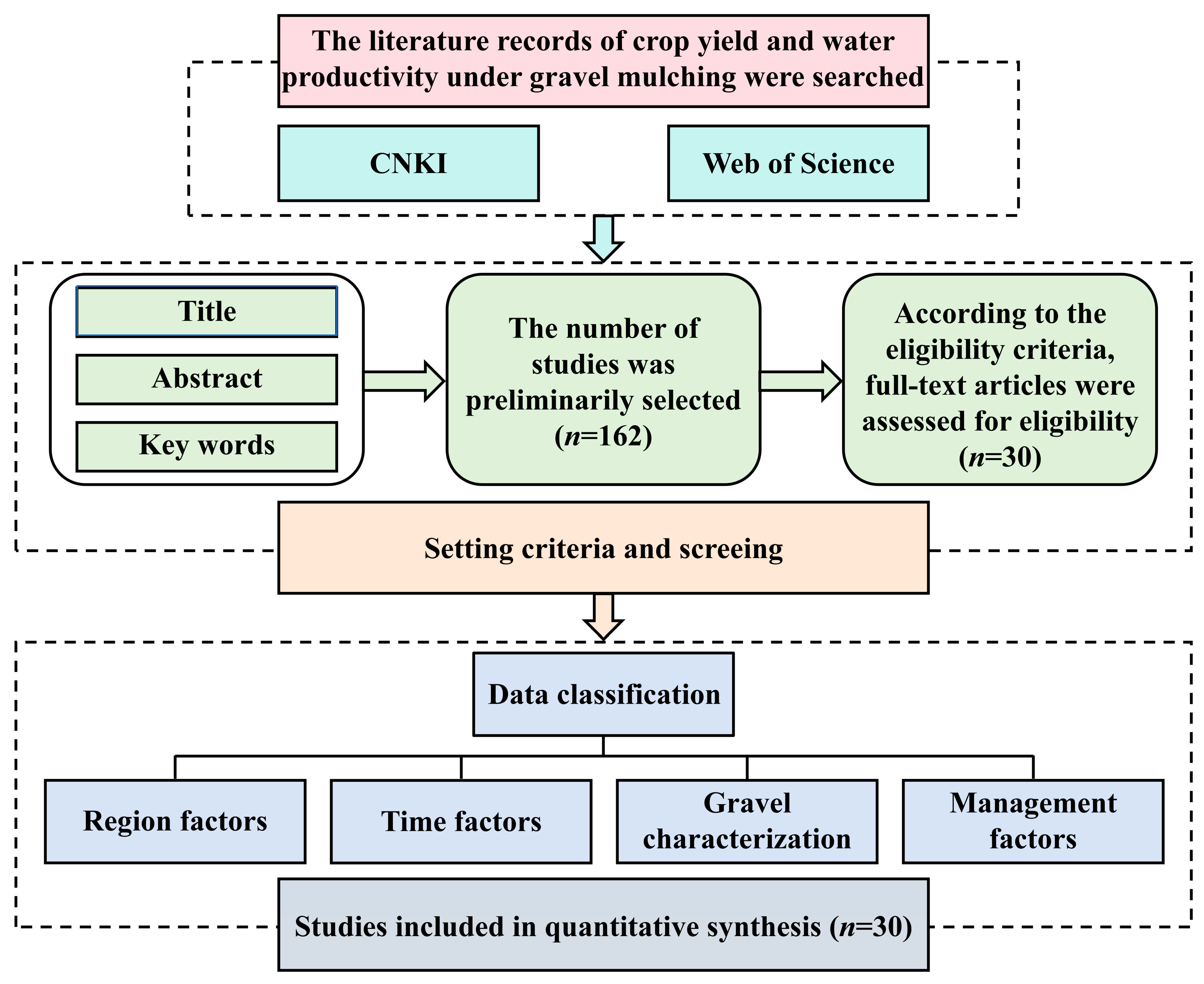
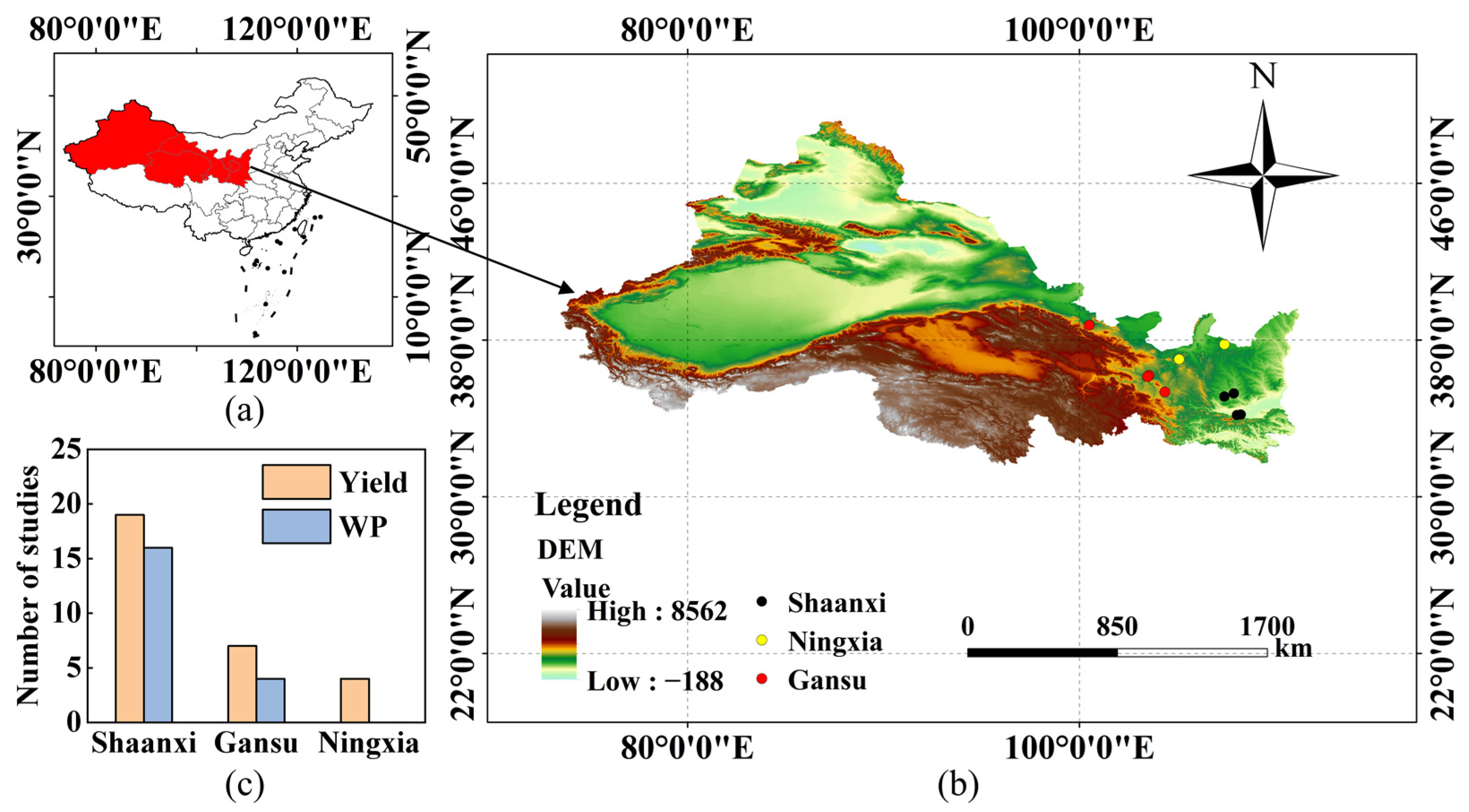
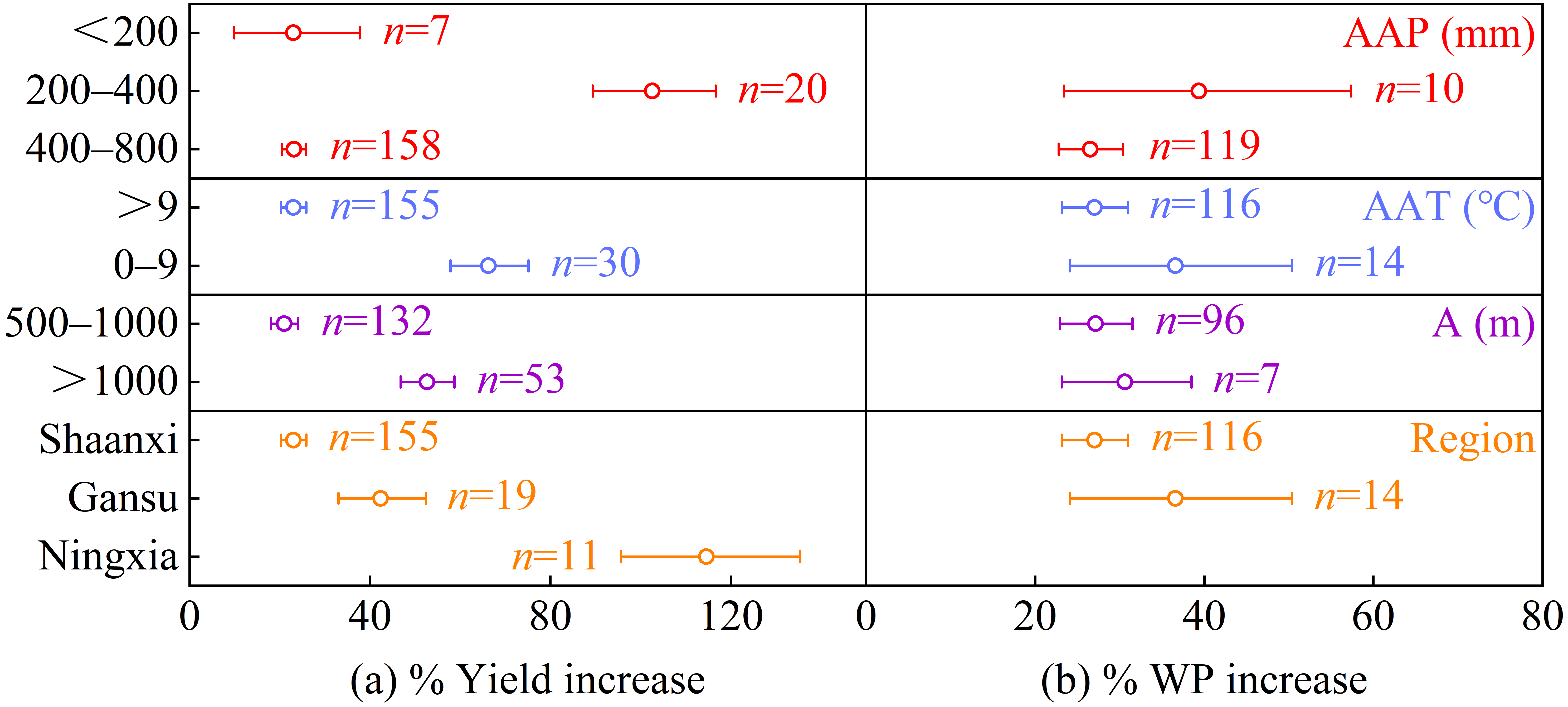
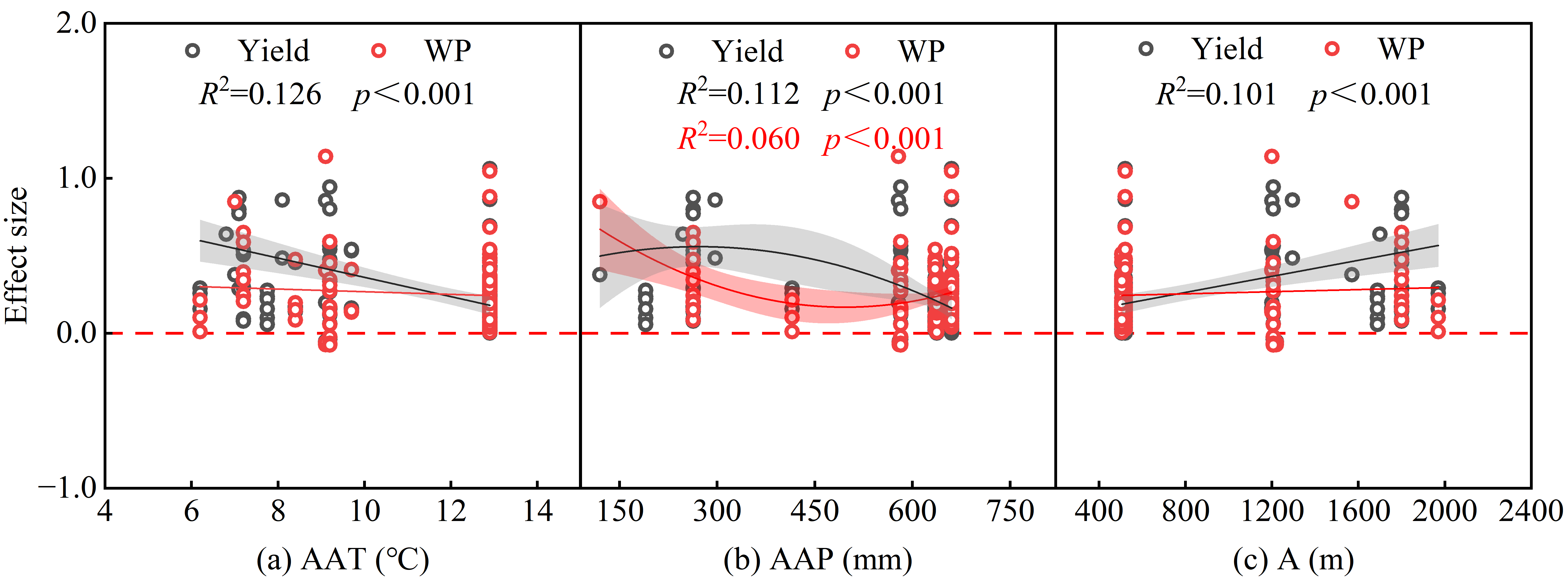


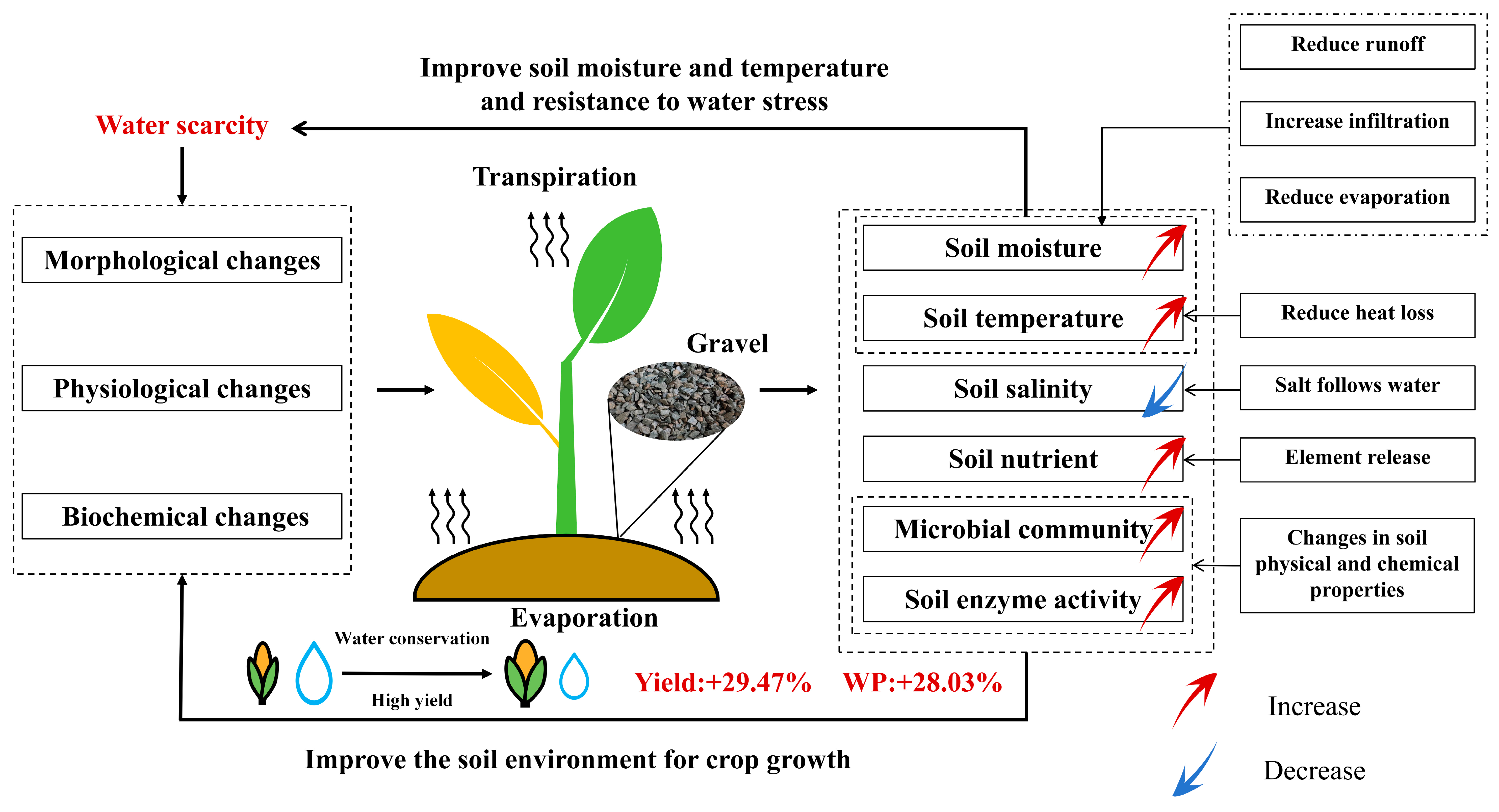
| Factors | Subgroups | Sample Size | |
|---|---|---|---|
| Regional factors | Region | Shaanxi, Gansu, Ningxia | 185 (130) |
| AAP | <200, 200–400, 400–800 mm | 185 (129) | |
| AAT | 0–9, >9 °C | 185 (130) | |
| A | 500–1000, >1000 m | 185 (130) | |
| Time factors | Experimental year | ≤2010, 2011–2015, ≥2016 | 184 (130) |
| Management factors | Fertilization measures | Fertilization, no fertilization | 178 (127) |
| Moisture management | Rainfed, irrigated | 185 (130) | |
| Crop type | Food crops, cash crops | 185 (130) | |
| Gravel characterization factors | GS | <1, 1–3, >3 cm | 167 (121) |
| DGM | Partial mulching, full mulching | 185 (130) | |
| GMT | <3, 3–6, >6 cm | 95 (83) | |
| AGM | <23, 23–46, >46 kg/m2 | 95 (59) | |
| Item | Model | Increase Rate (%) | 95% Confidence Interval | Total Heterogeneity | Fail-Safe Number | n | ||
|---|---|---|---|---|---|---|---|---|
| Lower Limit (%) | Upper Limit (%) | Q | PQ | |||||
| Yield | Random-effects model | 29.47 | 26.78 | 32.22 | 1193.31 | 0.000 ** | 40,425.80 | 185 |
| WP | Random-effects model | 28.03 | 24.37 | 31.80 | 181.56 | 0.002 ** | 13,696.90 | 130 |
| Item | Factors | Relative Contribution of Each Factor (%) | Regression Relation | R2 | F |
|---|---|---|---|---|---|
| Yield | AAP, AAT, A | −3.77, 43.14, 53.09 | Yield = 75.54A + 1.31 × 104AAT − 19.30AAP − 1.90 × 105 | 0.738 ** | 164.60 |
| GMT, GS | 82.63, 17.37 | Yield = 4.33 × 103GMT + 1.78 × 103GS − 5.72 × 103 | 0.647 ** | 70.64 | |
| WP | AAP | 100.00 | WP = 283.30 − 0.41AAP | 0.701 ** | 300.23 |
| GMT | 100.00 | WP = 14.32GMT − 18.63 | 0.613 ** | 120.20 |
Disclaimer/Publisher’s Note: The statements, opinions and data contained in all publications are solely those of the individual author(s) and contributor(s) and not of MDPI and/or the editor(s). MDPI and/or the editor(s) disclaim responsibility for any injury to people or property resulting from any ideas, methods, instructions or products referred to in the content. |
© 2024 by the authors. Licensee MDPI, Basel, Switzerland. This article is an open access article distributed under the terms and conditions of the Creative Commons Attribution (CC BY) license (https://creativecommons.org/licenses/by/4.0/).
Share and Cite
Wu, Y.; Jia, Z.; Li, W.; Gao, S.; Zhang, X.; Niu, X.; Huang, Y. Gravel Mulching Significantly Improves Crop Yield and Water Productivity in Arid and Semi-Arid Regions of Northwest China: Evidence from a Meta-Analysis. Agronomy 2024, 14, 1717. https://doi.org/10.3390/agronomy14081717
Wu Y, Jia Z, Li W, Gao S, Zhang X, Niu X, Huang Y. Gravel Mulching Significantly Improves Crop Yield and Water Productivity in Arid and Semi-Arid Regions of Northwest China: Evidence from a Meta-Analysis. Agronomy. 2024; 14(8):1717. https://doi.org/10.3390/agronomy14081717
Chicago/Turabian StyleWu, Yangyang, Zhenjiang Jia, Wangcheng Li, Susu Gao, Xin Zhang, Xiaoxiao Niu, and Yahao Huang. 2024. "Gravel Mulching Significantly Improves Crop Yield and Water Productivity in Arid and Semi-Arid Regions of Northwest China: Evidence from a Meta-Analysis" Agronomy 14, no. 8: 1717. https://doi.org/10.3390/agronomy14081717
APA StyleWu, Y., Jia, Z., Li, W., Gao, S., Zhang, X., Niu, X., & Huang, Y. (2024). Gravel Mulching Significantly Improves Crop Yield and Water Productivity in Arid and Semi-Arid Regions of Northwest China: Evidence from a Meta-Analysis. Agronomy, 14(8), 1717. https://doi.org/10.3390/agronomy14081717






